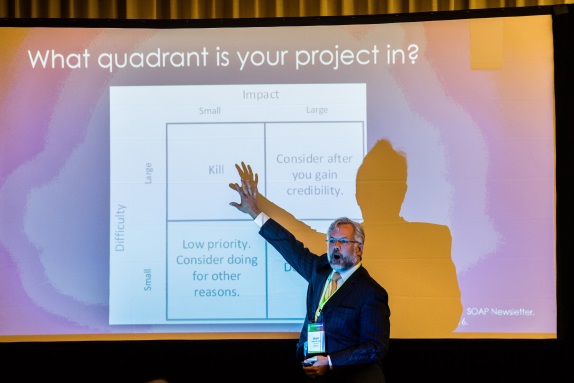
The key to engaging physicians in meaningful quality improvement (QI) and practice improvement (PI) initiatives is to determine what is meaningful to them, noted Grant Lynde, MD, Associate Professor and Chief of Practice and Process Improvement in the Department of Anesthesiology at Emory University in Atlanta. Dr. Lynde shared his formula for meaningful projects.
Whether the QI/PI effort is designed to improve patient care, decrease costs and enhance value, or demonstrate competency, “you need to get the right people on the bus,” Dr. Lynde said. Next, ask physicians what they’re curious about, what are their biggest pain points, and/or what makes them unhappy. What do their customers (those paying the bill) and consumers (those using the services) want? “Meaningful projects touch on our core values,” he stated.
Meaningful projects also use clear metrics, clearly define success, foster relationships/teams/collaboration, acknowledge wins, and make a difference.
Dr. Lynde, who is an American Board of Anesthesiology certified anesthesiologist participating in Maintenance of Certification, discussed two successful QI/PI efforts at Emory University Hospital. One set out to improve provider compliance with lung-protective ventilation strategies during general anesthesia. When lung-protective strategies are used for patients in the intensive care unit, they have better outcomes because bigger breaths can lead to lung injury. However, these strategies are not considered “normal” practice in the operating room and it’s unclear what the ideal tidal volume default setting should be on the ventilator. He formed a team with a clinician informaticist, an informatics analyst, and a data analyst. They searched the hospital’s clinical data repository to determine the median tidal volume for a patient’s height and predicted body weight (PBW). They changed the ventilator defaults and affixed the PBW table on the providers’ computer desktops. They sent a letter to 300 physicians and residents explaining why the ventilator defaults were changed and indicated the department goal for using the lung-protective strategies. They sent follow-up emails with periodic dashboards showing individual and department-level progress toward the goal. The data was presented as a chart with data definitions, references for metrics, and a human point of contact for additional information. They achieved a 94 percent compliance rate.
This QI/PI initiative was meaningful because conforming to the latest science spoke to the physicians’ core values, the metrics were clear (<8 cc/kg PBW ventilation), the success was clearly defined (a greater than 95 percent compliance rate), it fostered relationships as the team grew, it acknowledged “wins” with a quarterly dashboard, and it made a difference by lowering pneumonia rates by 40 percent from baseline.
Improving prophylactic antibiotic administration was another successful QI/PI initiative Dr. Lynde noted. It’s known that antibiotics given in a timely fashion result in a 50 percent decrease in post-operative wound infections. However, the right drug and dose must be given at the right time. According to the Surgical Care Improvement Project (SCIP), antibiotics must be administered no more than 60 minutes prior to incision (120 minutes for vancomycin or fluoroquinolones). The hospital’s documented rate with SCIP guidelines was 99.9 percent, but a document review indicated that most surgical patients who developed infections did not receive antibiotics. The team he formed consisted of a surgeon, nurse, an infectious diseases nurse and physician, two data informaticists, a data analyst, a project manager, an operating room pharmacy manager, and an infectious diseases pharmacist. They streamlined antibiotic procurement, standardized antibiotic selection, and developed an algorithm that included a daily notification and monthly scorecard. As compliance increased, infection rates decreased. Ultimately, they achieved a 96 percent compliance rate with the QI/PI project.
This QI/PI effort was meaningful because “doing no harm” spoke to the physicians’ core values, the metrics were clear (right drug, right dose, right time), the success was clearly defined (a greater than 95 percent compliance rate), it fostered relationships across the institution, it acknowledged “wins” with a monthly dashboard, and it made a difference by lowering post-operative wound infections by 57 percent from baseline.
Lastly, meaningful projects should have sustainability. Dr. Lynde offered the following tips to help sustain QI/PI initiatives:
- Make doing it right easier than doing it wrong
- Provide automated feedback
- Reject workarounds
- Align incentives and process
- Focus on process metrics, not outcomes
- Empower employees
- Use “no fault” reporting
- Change the culture
- Celebrate genuine successes
- Strengthen teams, create trust
© 2019, American Board of Medical Specialties
